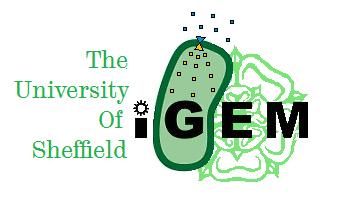Team:University of Sheffield /Project
From 2008.igem.org
| Line 31: | Line 31: | ||
[[Image:Sheffield_igem_logo.JPG|300px]] | [[Image:Sheffield_igem_logo.JPG|300px]] | ||
</DIV> | </DIV> | ||
| + | |||
<table> | <table> | ||
<tr><td> | <tr><td> | ||
| Line 36: | Line 37: | ||
|<H2>Project Overview</H2><br> | |<H2>Project Overview</H2><br> | ||
<p>We want is to engineer a biological machine that will sense microbial contamination of drinking water using quorum sensing, namely the system in '''''Vibrio cholerae''''', the bacterial species that causes epidemics of cholera. Quorum sensing systems use sensing proteins in the membrane (<em>[http://en.wikipedia.org/wiki/Histidine_kinase histidine-kinases] in this case</em>) to detect molecules excreted by the bacteria’s own species. After detection in the membrane, a phosphate signal is passed down pathway, causing a DNA regulatory effect. Each quorum-sensing species also has its own corresponding quorum-producing protein. In Vibrio cholerae the sensing protein is CqsS and the quorum-producing protein CqsA.</p> | <p>We want is to engineer a biological machine that will sense microbial contamination of drinking water using quorum sensing, namely the system in '''''Vibrio cholerae''''', the bacterial species that causes epidemics of cholera. Quorum sensing systems use sensing proteins in the membrane (<em>[http://en.wikipedia.org/wiki/Histidine_kinase histidine-kinases] in this case</em>) to detect molecules excreted by the bacteria’s own species. After detection in the membrane, a phosphate signal is passed down pathway, causing a DNA regulatory effect. Each quorum-sensing species also has its own corresponding quorum-producing protein. In Vibrio cholerae the sensing protein is CqsS and the quorum-producing protein CqsA.</p> | ||
| - | |||
| - | |||
| - | |||
| - | |||
| - | |||
| - | |||
| - | |||
| - | |||
| - | |||
|} | |} | ||
</td> | </td> | ||
| - | |||
<td> | <td> | ||
{|style="background-color:#6699FF;" cellpadding="20" cellspacing="0" border="5" bordercolor="blue" align="center" | {|style="background-color:#6699FF;" cellpadding="20" cellspacing="0" border="5" bordercolor="blue" align="center" | ||
| - | |<H2>History of | + | |<H2>History of<br><br> Development</H2> |
*[[Team:University_of_Sheffield / Initial_BrSt |Early Brainstorming & Other Crazy Ideas]] | *[[Team:University_of_Sheffield / Initial_BrSt |Early Brainstorming & Other Crazy Ideas]] | ||
*[[Team:University_of_Sheffield / Late_BrSt |A Selected Primary Idea: Sensing Pathogens & Biochip]] | *[[Team:University_of_Sheffield / Late_BrSt |A Selected Primary Idea: Sensing Pathogens & Biochip]] | ||
| Line 56: | Line 47: | ||
*[[Team:University_of_Sheffield / Project_v2.0 |The final proposal: The hybrid-hybrid Sensor]] | *[[Team:University_of_Sheffield / Project_v2.0 |The final proposal: The hybrid-hybrid Sensor]] | ||
|} | |} | ||
| - | + | ||
{|style="background-color:#6699FF;" cellpadding="20" cellspacing="0" border="5" bordercolor="blue" align="center" | {|style="background-color:#6699FF;" cellpadding="20" cellspacing="0" border="5" bordercolor="blue" align="center" | ||
|<H2>More Details</H2> | |<H2>More Details</H2> | ||
| Line 65: | Line 56: | ||
</td></tr> | </td></tr> | ||
</table> | </table> | ||
| + | |||
| + | {|style="background-color:#6699FF;" cellpadding="20" cellspacing="0" border="5" bordercolor="blue" | ||
| + | |<H2>If everything goes well...</H2><br> | ||
| + | <p>We are hijacking a pathway already present in E.coli – the non-essential BarA, pathway which is partly responsible for 'last resort' carbon metabolism. This pathway starts with similar histidine-kinase (<em>KdpD</em>) to Vibrio cholerae, and makes a compatible candidate topologically. We're taking the sending part of the Vibrio cholerae histidine kinase (called CqsS) and attaching it to the phosphotransfer part of the BarA histidine kinase, forming a new, fusion kinase. This is the simple way of putting it, as fusion proteins are notoriously difficult to get to work in reality. However the similiar topology between BarA and CqsS helps us somewhat, and sessions with Prof Rice (a protein crystollogropher in the Molecular Biology and Biotechnology department here) have increased our chances of a succesfulm protein. | ||
| + | When triggered, out fusion kinase will pass the signal down E.coli's natural BarA response system to its target genes, with which we are fusing GFP. In short, is cholera autoinducers are in the water, our cell will glow! The original BarA will be knocked out of E.coli to make way for recombinant receptors (we dont want native BarA triggering our GFP!). | ||
| + | |||
| + | The recombinant protein will be expressed on a high-copy plasmid, so we should be able to get large-scale production of the recombinant proteins which may lower the threshold number of quorum molecules required to trigger the pathway.</p> | ||
| + | |} | ||
Revision as of 22:27, 28 September 2008
| Home | Our project | Modelling | Parts | Lab Books | Calendar | Administration |
|---|
|
|
If everything goes well...We are hijacking a pathway already present in E.coli – the non-essential BarA, pathway which is partly responsible for 'last resort' carbon metabolism. This pathway starts with similar histidine-kinase (KdpD) to Vibrio cholerae, and makes a compatible candidate topologically. We're taking the sending part of the Vibrio cholerae histidine kinase (called CqsS) and attaching it to the phosphotransfer part of the BarA histidine kinase, forming a new, fusion kinase. This is the simple way of putting it, as fusion proteins are notoriously difficult to get to work in reality. However the similiar topology between BarA and CqsS helps us somewhat, and sessions with Prof Rice (a protein crystollogropher in the Molecular Biology and Biotechnology department here) have increased our chances of a succesfulm protein. When triggered, out fusion kinase will pass the signal down E.coli's natural BarA response system to its target genes, with which we are fusing GFP. In short, is cholera autoinducers are in the water, our cell will glow! The original BarA will be knocked out of E.coli to make way for recombinant receptors (we dont want native BarA triggering our GFP!). The recombinant protein will be expressed on a high-copy plasmid, so we should be able to get large-scale production of the recombinant proteins which may lower the threshold number of quorum molecules required to trigger the pathway. |
 "
"
